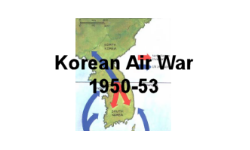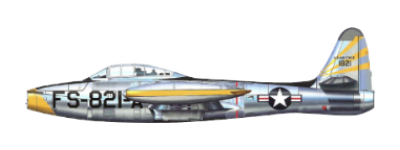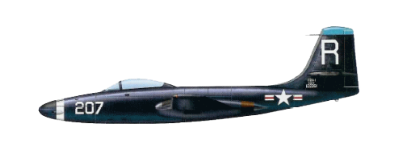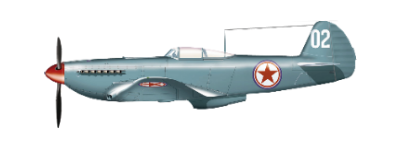The Hawker Fury was an evolutionary successor to the successful Hawker Typhoon and Tempest fighters and fighter-bombers of World War II. Developed during the Second World War, the Hawker Sea Fury entered service two years after the war ended. The Sea Fury proved to be a popular aircraft with a number of overseas militaries, and was used during the Korean War in the early 1950s. It was the last propeller-driven fighter to serve with the Royal Navy and also one of the fastest production single piston-engined aircraft ever built.
Back to Top
Development
The Fury's design process was initiated in September 1942 by Sydney Camm, to meet the Royal Air Force's requirement for a lightweight Tempest Mk.II replacement. The 'Tempest', while a successful aircraft, had been viewed as being heavy and oversized for typical fighter duties. Developed as the 'Tempest Light Fighter', the semi-elliptical wing of the Tempest was incorporated, but was shortened in span by attaching the two wings at the aircraft centreline, eliminating the centre-section. The fuselage itself was broadly similar in form to that of the Tempest, but was a fully monocoque structure, while the cockpit level was higher, affording the pilot better all round visibility. The project was formalised in January 1943 when the Air Ministry issued Specification F.2/42 around the 'Tempest Light Fighter'. This was followed up by Specification F.2/43, issued in May 1943, which required a high rate of climb of not less than 4,500 ft/min (23 m/s) from ground level to 20,000 feet (6,096 m), good fighting manoeuvrability and a maximum speed of at least 450 mph (724 km/h) at 22,000 feet (6,705 m). The armament was to be four 20mm Hispano V cannon with a total capacity of 600 rounds, plus the capability of carrying two bombs each up to 1,000 pounds (454 kg). In April 1943, Hawker had also received Specification N.7/43 from the Admiralty, who sought a navalised version of the developing aircraft and in response, Sidney Camm proposed the consolidation of both service's requirements under Specification F.2/43, with the alterations required for naval operations issued on a supplemental basis. Around 1944, the aircraft project finally received its name, the Royal Air Force's version becoming known as the Fury and the Fleet Air Army's version as the Sea Fury with responsibility for the naval conversion being assigned to Boulton-Paul Aircraft Ltd. In April of 1944 contracts were placed for 200 aircraft for each the Royal Air Force and Fleet Air Arm. The Boulton Paul contract was cancelled in early 1945, and of the 100 Sea Furies that remained on order, the first 50 were completed under the designation Sea Fury Mk X. The first Sea Fury prototype flew on February 21, 1945, but the first full naval version with folding wings did not fly until October 12, 1947. The first production model, the Sea Fury F Mk X (Fighter, Mk 10), flew in September 1946. With the completion of flight testing at Boscombe Down in 1946, the trials process was repeated aboard the aircraft carrier HMS Victorious. Carrier testing revealed directional stability issues related to rudder effectiveness during landing, and this was resolved by the adoption of a tail wheel lock, which also improved the wheel retraction behaviour. Later, the adoption of a five-bladed Rotol propeller to greatly reduce overspeed tendencies, a re-designed rudder assembly to increase rudder effectiveness, Dynafocal engine mountings to reduce vibration at low speeds, and an improved undercarriage with greater flexibility.
Back to Top
Into Service
Following the outbreak of the Korean War on 25 June 1950, Sea Furies were dispatched to the region as a part of the British Commonwealth Forces Korea, Britain's contribution to the United Nations multinational task force to assist South Korea following an invasion by North Korea. Sea Furies were flown throughout the conflict, primarily as ground-attack aircraft, from the Royal Navy light fleet carriers HMS Glory, HMS Theseus, HMS Ocean, and the Australian carrier HMAS Sydney. Operations on HMS Theseus were intense, and the Sea Furies of 807 Squadron flew a total of 264 combat sorties in October. During a brief rest period at the Japanese port of Iwakuni the catapult was found to be excessively worn, necessitating the launch of Sea Furies with RATOG assistance until it was repaired. In December 1950, Sea Furies conducted several strikes on bridges, airfields, and railways to disrupt North Korean logistics, flying a further 332 sorties without incurring any losses. At this early point in the war little aerial resistance was encountered and the biggest threats were ground-based anti-aircraft fire or technical problems. In addition to their ground attack role, Sea Furies also performed air patrols. In this role, a total of 3,900 interceptions were carried out, although none of the intercepted aircraft turned out to be hostile. During the winter period, the Sea Furies were often called upon as spotter aircraft for UN artillery around Inchon, Wonsan, and Songiin. In April 1951, 804 Naval Air Squadron operating off HMS Glory, replaced 807 Squadron, which in turn was replaced by HMAS Sydney in September 1951 with 805 and 808 Squadron RAN. The Australian carrier air group flew 2,366 combat sorties.In January 1952, HMS Glory with 804 NAS returned to relieve HMAS Sydney following a refit in Australia. For the rest of the war HMS Glory and HMS Ocean relieved each other on duty. After a Fleet Air Arm Seafire was shot down by a United States Air Force Boeing B-29 'Superfortress' on 28 July 1950, all Commonwealth aircraft were painted with black and white Invasion Stripes. On 8 August 1952, Lieutenant Peter "Hoagy" Carmichael, of 802 Squadron, flying Sea Fury WJ232 from HMS Ocean, shot a MiG-15 down, making him one of only a few pilots of a propeller driven aircraft to shoot down a jet. The engagement occurred when a formation of Sea Furies and Fireflies were engaged by eight MiG-15s, during which one Firefly was badly damaged while the Sea Furies escaped unharmed.
Back to Top
Export
Canada
The Royal Canadian Navy (RCN) became a significant customer of the Sea Fury, and many of its aircraft were diverted from existing Royal Navy contracts. On 23 June 1948, the first aircraft was accepted at RCAF Rockcliffe. The type was quickly put to use replacing Canada's existing inventory of Seafires, taking on the primary role of fleet air defence operating from the aircraft carrier HMCS Magnificent. Two Canadian squadrons operated the Sea Fury, Nos. 803 and 883 Squadrons, which were later renumbered as 870 and 871.
Australia
Australia was one of three Commonwealth nations to operate the Sea Fury, with the others being Canada and Pakistan. The type was operated by two frontline squadrons of the Royal Australian Navy, 805 Squadron and 808 Squadron; a third squadron that flew the Sea Fury, 850 Squadron, was also briefly active. Two Australian aircraft carriers, HMAS Sydney and HMAS Vengeance, employed Sea Furies in their air wings. The Sea Fury was used by Australia during the Korean War, flying from carriers based along the Korean coast in support of friendly ground forces. The Sea Fury was operated by Australian forces between 1948 and 1962.
Back to Top
Other Exports
The Sea Fury became an export success, being purchased both to operate on foreign aircraft carriers and for purely land-based roles by a number of other nations, including Germany, Iraq, Egypt, Burma, Pakistan and Cuba. Several of the nations that did not have active aircraft carriers often had the tail hooks and catapult hooks removed from their aircraft. Upon the type's withdrawal from military service, a large number of Sea Furies were sold onto private individuals, often as a racing aircraft due to its high speed.
The final production figures for all marks reached around 860 aircraft.




 Korean War
Korean War P-80 Shooting Star
P-80 Shooting Star F-84 Thunderjet
F-84 Thunderjet F-86 Sabre
F-86 Sabre AD1 Skyraider
AD1 Skyraider F2H Banshee
F2H Banshee F9F Panther
F9F Panther Seafury
Seafury Meteor
Meteor Mig-15
Mig-15 Yak-9
Yak-9 IL-10 Shturmovik
IL-10 Shturmovik



 Hawker 'Sea Fury'
Hawker 'Sea Fury'
